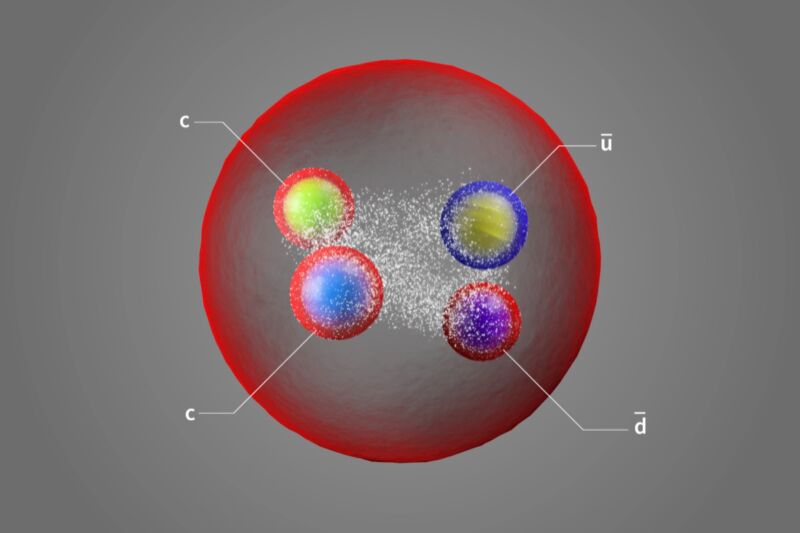
The exotic family of particles known as tetraquarks has a surprising new member. Dubbed Tcc+, it's the first tetraquark to contain two heavy quarks and two light antiquarks, and it's the longest-lived exotic matter particle yet discovered. Representatives for the LHCb collaboration at CERN's Large Hadron Collider made the announcement last week at the European Physical Society Conference on High Energy Physics in Germany, hosted jointly by Universität Hamburg and DESY.
Quarks are the most fundamental building blocks of matter, first proposed in 1964 by Murray Gell-Mann and George Zweig. Quarks come in six different flavors, all differing in mass and charge: up, down, strange, charm, bottom, and top (from lightest to the heaviest), along with their corresponding antiquarks. They typically clump together in groups of two or three to form hadrons, held together by force-carrying particles known as gluons. Ordinary baryons are hadrons that include the proton and neutron of an atom, each made up of three-quark combinations, while hadronic particles known as mesons are formed from quark-antiquark pairs. Think of quarks as the LEGO bricks of the subatomic world, mixing and matching in various combinations to form more complicated structures.
Gell-Mann thought there might be more exotic hadrons formed from quark combinations of four or even five quarks, but these existed solely in the realm of theory until quite recently. That's because such exotic heavy particles decay very rapidly into more stable byproduct particles within fractions of a second. It's those byproducts that show up in particle accelerator detectors, amounting to distinctive signatures for their heavier precursor particles. But it's extremely difficult to tease out those signatures from all the noise in the vast amounts of data produced in particle collisions.
Japanese physicists found the first experimental evidence for tetraquarks in 2003, and the family has been growing ever since. For instance, LHCb physicists confirmed the discovery of the tetraquark Z(4430) in 2014, several years after it first showed up in the Belle detector at Japan's KEKB accelerator. Two years later, in 2016, physicists analyzing 2002-2011 data from Fermilab's now-retired Tevatron accelerator discovered another new tetraquark—dubbed X(5568)—made up of quarks of four different flavors: up, down, strange, and bottom. Prior tetraquarks were typically composed of at least two quarks of the same flavor, making X(5568) something of an anomaly even among this class of exotic particles.
Last year, CERN announced yet another new addition to the growing family of tetraquarks: a collection of two charm quarks and two anti-charm quarks that made up a massive tetraquark. It was the first such particle discovered with more than three quarks composed entirely of just one type of quark. It was also the first to be composed entirely of heavier quarks. Just the year before, the LHCb collaboration had discovered two pentaquarks, confirming that discovery in 2019, along with the discovery of a third pentaquark.
The new Tcc+ tetraquark only lasts a mere one-quintillionth of a second before decaying into a pair of mesons, each with one heavy quark and one light antiquark. That's still roughly ten times longer than its siblings. It owes that relative stability to its unusual structure: two heavy charm quarks and two light anti-quarks, a combination physicists call a "double charm" tetraquark. That makes the tetraquark only slightly heavier than its meson byproducts, and thus it decays a bit more slowly. The longer lifetime also means this is the first time physicists have been able to precisely measure the mass of a tetraquark, showing up as a large peak, or "bump," in the data.
The discovery brings us one step closer to a better understanding of the complicated underlying rules that govern how these exotic particles are combined, and it paves the way for a future discovery of even heavier exotic hadrons—perhaps a tetraquark that replaces the two charm quarks with two bottom quarks (dubbed Tbb), which would have an even longer lifetime. For now, significant questions still remain about how these exotic particles are made. As Ars' John Timmer reported last year:
There are two possibilities that are being considered. In one case, the new high-quark-count particles are made the same way that familiar ones are: gluons bind them tightly together into a single particle. An alternative, however, is that the large number of quarks comes about because two more familiar particles are tightly associated. So, a tetraquark could simply be a tight association of a pair of two-quark particles. A pentaquark would be put together from a two-quark meson associating with a three-quark particle.
"Right now, it's not yet clear," Syracuse University postdoc and LHCb physicist Ivan Polyakov told Symmetry magazine. "We have measured its mass and the width of the peak very precisely. This will prompt theorists to make more accurate calculations and hopefully develop a deeper understanding of exotic hadrons." And once the latest upgrades to the LHCb detector are complete, there's a good chance even more exotic hadrons will be discovered.



3175x175(CURRENT).thumb.jpg.b05acc060982b36f5891ba728e6d953c.jpg)

Recommended Comments
There are no comments to display.
Join the conversation
You can post now and register later. If you have an account, sign in now to post with your account.
Note: Your post will require moderator approval before it will be visible.